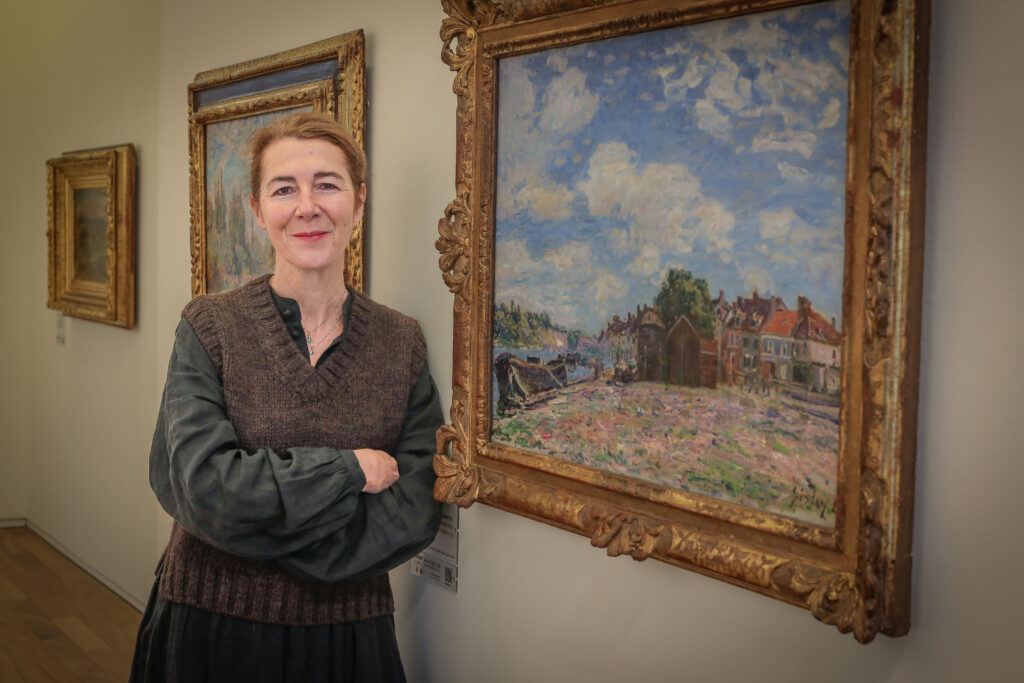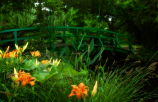Interviews
Géraldine Lefebvre :
«Giverny is a masterpiece of land art!»
Géraldine Lefebvre, a Doctor of Art History and 19th century specialist, has taken up the post of museum director at MuMa (André-Malreaux museum of modern art) in Le Havre. Being a fan of Claude Monet, she enthusiastically and aptly chats with us about the impressionist movement

History chose the 15th of April 1874 – the date of the first impressionist exhibition – as the date the movement was born. But how long had it already existed in aesthetic terms?
In fact, impressionism already existed in 1874. But it had not yet become a ‘political action’. Its manifesto came into being in 1874. At the first impressionist exhibition, the artists introduced a new way to see and paint. It was a non-conformist exhibition with a revolutionary angle. A rebellious act against the Academy. Until then, historical, mythological and large scale paintings dominated the Salon’s picture rails. Depicting modern life and people on large canvases was new! In 1868, Claude Monet revealed his desire for a new way of painting at the Le Havre international maritime exhibition. He exhibited ‘Camille, the Woman in the Green Dress’, an artwork on a huge scale normally reserved for historical paintings. This was an early indication of his desire to leave his mark on the history of art. The 1868 exhibition could almost be considered an impressionist pre-exhibition, because it was such an historical milestone!
Would you say that the exhibition on 15 April 1874 had a whiff of scandal about it?
Yes, but perhaps not for everyone. There were more traditional artists, including engravers and sculptors, exhibiting alongside Boudin, Monet, Pissarro and Sisley. Not everyone was a revolutionary artist.
One of the exhibited artworks was Claude Monet’s ‘Impression, sunrise’. Its name was as innovative as its style…
Edmond Renoir, the artist’s brother, was tasked with editing the catalogue and asked Claude Monet to give his painting a name. “It could not really be labelled a view of Le Havre,” Monet later recalled. “So I replied: Put ‘Impression’!” In fact, this was the first time a painting had been presented as such, without identifying the location. And it had an ‘unfinished’ look about it too.
It was the journalist Louis Leroy of the Charivari who unwittingly gave the movement its name. And even gave it credibility!
He highlighted the word ‘impression’ and made fun of it. He gave his article the title: ‘The Exhibition of Impressionists”! There was an amazing convergence of artists who had decided to paint in a new way and this journalist who, with his witty remark, created the split. That’s exactly what happened in 1905 with the Fauvists. A journalist’s clever remark acknowledged the birth of Fauvism!
These pioneering artists embraced the term ‘Impressionism’. But did they want to be labelled?
They had a desire to start something new without being tied to a label. These artists were freeing themselves from the constraints of the Academy which, in the first half of the 19th century, boxed artists in with predefined labels. The impressionists did not fall under any school so felt themselves to be multidisciplinary and eclectic. At the first impressionist exhibition, Renoir founded an anonymous society because he wanted the artists to grow their style as they wanted. Each person carries their own message in their heart. People desire to remain free and to work in their own way.
“The motif is secondary; what I want to capture is what there is between the motif and myself.” This quote from Claude Monet could be a definition of impressionism. What would be yours?
You cannot understand impressionism without considering the scientific advances of the 19th century. These artists worked using more developed technical means. They could work in new ways, outside the studio. Paint tubes enabled them to stand facing the landscape. Synthetic pigments gave them new colours. These artists also experienced major technological advances: trains, speed, major infrastructure and more. Impressionist artists could embed themselves in their era and become part of the landscape. They lived in a fast-moving, ever-changing world. In my opinion, in their own individual ways, impressionist artists are those who interpreted the major changes in the second half of the 19th century. Those who depicted what they perceived in modern reality, through their own lens. Claude Monet completely immersed himself in his own period while also, towards the end of his life, entirely removing himself from it to refocus on one motif. He went beyond it, enhanced it, and heralded the major changes of the 20th century.
During their career, each artist’s own vision of impressionism evolved…
In the beginning, Claude Monet painted what he saw and perceived of his external reality. That is why his paintings focussed on his family. They reflected a social, countryside vision of the setting in which he grew up. He also painted many gardens. Then, particularly in London, he developed his interest for a place’s atmosphere. Monet shifted his focus from the place itself to the moving light and reflections. In 1874 he exhibited pastels that were entirely in that vein. He depicted the light’s effect on landscapes, captured sunsets and more. In the 1890s and 1900s, he moved onto other things…
When were the impressionists embraced by the general public?
In 1885, art dealer Paul Durand-Ruel had the brilliant idea of organising an exhibition in New York. All the artworks were sold! The American public was the first to truly recognise the impressionists. Before then, those artists had been entirely misunderstood. The first sale in 1875 was a fiasco. Only a few collectors on the fringes – such as Ernest Hoschedé and Georges de Bellio – and some family and friends – including Léon Monet – turned up. The first ten years proved complicated. But after 1885, the impressionists started to hope they could make a living from their paintings. That is when Claude Monet moved to Giverny. His popularity soared in 1891 with the Haystacks exhibition. Around 1900, major collectors had already added impressionist artworks to their collections.
The role played by major collectors from Le Havre in promoting impressionism is little-known…
They became interested in this pictorial movement from the early 1890s. In 1901, the Musée du Havre’s acquisition committee (comprising major collectors such as Georges Dussueil and Auguste Marande, and the mayor) decided to add impressionism artworks to the collections. The commission even went against the curator’s decision! They purchased works by accessible artists such as Maxime Maufra. It was the first time that impressionist art had been acknowledged by a museum and a city. In August 1903, the city of Le Havre bought two artworks from Pissarro. Those two paintings were the first and only artworks bought from the artist by a French museum while he was alive.
The foundational artwork ‘Impression, sunrise’ was painted in Le Havre. Does this masterpiece illustrate Claude Monet’s deep attachment to Le Havre?
Claude Monet’s attachment to Le Havre is extremely important. He had very strong ties to the region. It was here, with Boudin, that his eyes were opened to landscape painting. His first two sketch books were entirely filled with Le Havre landscapes. He would happily travel ten kilometres in one day to capture a motif even though he was only 15 years old! Le Havre had everything: water, changing weather, passing clouds, the sea, reflections, and more. All of this hinted at his future journey along the River Seine and even to Giverny. You can see how his childhood in Le Havre influenced him. I think that the Giverny garden evokes aspects of the garden in which he grew up in Sainte Adresse. The Le Coteau villa’s flower bed was quite reminiscent of the one around his Giverny house.
How are Claude Monet’s gardens a good way to get to grips with impressionism?
This is where the artist painted for over 40 years. There is a clear link between the landscape and his artworks. He shaped his motif in order to paint it. It is a masterpiece of land art – a natural creation! Claude Monet brought his pond and water lilies to life, crafting even the smallest thickets. This garden is perhaps his best creation…
How is MuMa celebrating the 150th anniversary of impressionism?
Musée d’Orsay is loaning us two of Claude Monet’s best artworks: ‘Train in the Countryside’ (circa. 1870) and ‘Rouen Cathedral: The Portal Front View’ (1892). On 25 May, our ‘Photography in Normandy’ (1840-1890) exhibition will open. It shows how the arts influence each other. Photos by pioneering photographers form a dialogue with great artists such as Monet, Pissarro and Boudin.














